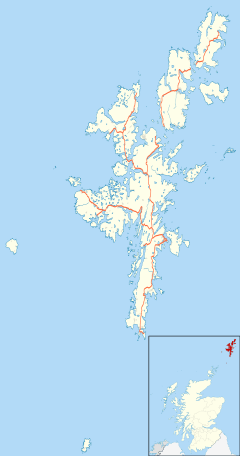Stanydale facts for kids
Quick facts for kids Stanydale |
|
|---|---|
 The road towards the hamlet of Stanydale |
|
| OS grid reference | HU285505 |
| Civil parish |
|
| Council area | |
| Country | Scotland |
| Sovereign state | United Kingdom |
| Post town | SHETLAND |
| Postcode district | ZE2 |
| Dialling code | 01595 |
| Police | Northern |
| Fire | Highlands and Islands |
| Ambulance | Scottish |
| EU Parliament | Scotland |
| UK Parliament |
|
| Scottish Parliament |
|
Stanydale is a small village, also known as a hamlet, located on Mainland. Mainland is the largest island in the Shetland group of islands, which are part of Scotland. Stanydale is a quiet place known for its beautiful countryside and interesting ancient sites nearby.
Contents
Exploring Stanydale: A Small Scottish Hamlet
Stanydale is a peaceful spot in the amazing Shetland Islands of Scotland. Even though it's a small community, it holds a lot of history. People who live here are often called crofters, which means they live and work on small farms called crofts. The area around Stanydale is perfect for exploring nature and discovering clues about how people lived thousands of years ago.
The Ancient Stanydale Temple
Just a short walk, less than half a mile, south of the houses in Stanydale, you can find an incredible old building called the Stanydale Temple. This isn't a temple like a church or mosque we see today. Instead, it's a very old building from the Stone Age, built around 4,000 years ago!
What is the Stanydale Temple?
The Stanydale Temple is a special archaeological site. It was built with large stones and has a unique shape, like a heel. This type of building is called a "heel-shaped cairn" or "heel-shaped house." Experts believe it might have been used for important community gatherings or ceremonies. It shows us how clever ancient people were at building strong structures that have lasted for thousands of years.
Mysterious Stone Cairns of Stanydale
To the north of Stanydale, on a ridge that's about 100 feet above the sea, there are three ancient stone piles called cairns. Cairns are human-made piles of stones. They were often used as burial mounds or as markers for important places in ancient times.
The West Cairn's Secrets
One of these cairns, the west cairn, was first described by archaeologists in 1931. It was a round pile of stones, about 50 feet across and 3 feet high. Over time, parts of it have been damaged, but it still stands as a reminder of the people who lived in Stanydale long, long ago. These cairns give us clues about the ancient history of the Shetland Islands and the people who called this place home.


